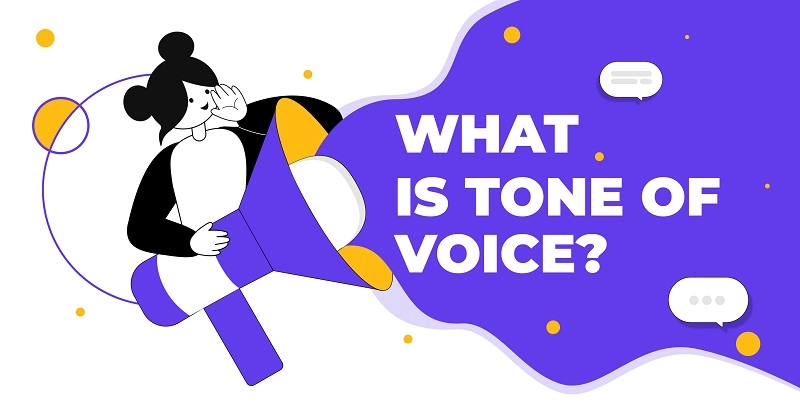Tone of Voice: Definition, Importance & How to Develop It
• Customer Support
• FastBank

People trust and remember businesses that have a consistent, recognizable brand identity. A distinct personality helps the company appear more reliable and established in the eyes of the consumer and connects with them on a more profound level.
Think of how you associate a certain way of talking with the people you know in real life. The same applies to brands: Once a company manages to develop a unique tone of voice, its audience starts to recognize the brand’s messaging even when the company name is not attached to it.
In this blog post, you’ll learn all about brand tone of voice, why it matters, and how to shape yours. Ready? Let’s begin!
What Is Tone of Voice?
Tone of voice is how a brand speaks to its audience, reflecting its personality and setting the mood through every message.
Now let’s dive in a bit more: what is tone of voice in communication? A company’s communication can be very diverse, including verbal as well as non-verbal interactions with customers across many touchpoints.
Merriam-Webster gives the following tone of voice definition: The way a person is speaking to someone.
This tone of voice definition mainly refers to the spoken word. However, tone of voice in communication between brands and their customers entails much more. In this sense, the term is mostly used in the context of written content that appears on social media, websites, emails, and conversations with clients.
Brand tone of voice reflects how a company chooses to present itself to the public and share its message with the customer. A lot of thought goes into crafting a brand’s writing style to ensure the latter is consistent with the company’s mission, visual style, and overall identity.
Why Do You Need a Tone of Voice?
Defining your tone of voice will impact nearly every aspect of your company — from its outward image to internal communication. Below are a few key reasons why it’s vital to define your company’s tone of voice.
Create a Recognizable Brand
Just like a unique visual style sets your company apart from the competition, so does a unique tone of voice. What is the level of formality in your written pieces? How do you comment on specific situations? Are you referring to your customers as peers or juniors?
Depending on your answer to these questions, your business will display a particular brand image, thus affecting the public’s perception of you. From human agents to AI customer service assistants, outdoor banners, and online copy, any communication with the user contributes to shaping that image.
Besides knowing what tone(s) to aim for in your communication, you should also observe some extent of consistency. As mentioned earlier, your tone of voice can vary on different channels. However, the tones you choose should still be congruent with one another and with your brand personality at large.
Strengthen Brand Consistency Across New Touchpoints
With the expansion of digital and physical touchpoints, maintaining consistency becomes a challenge. A clearly defined tone of voice ensures that whether your audience interacts with your brand on your website, via customer support, or through an app, they experience a unified and seamless communication style.
Build Trust With Your Target Audience
Consumers are more likely to trust a business that displays consistency in what they do. And consistency in their way of communication adds a lot of credibility to a brand. Regardless of how casual or formal your brand sounds, establishing a specific tone will increase your company’s authority, as it will create a solid persona to present to your audience.
Humanize Your Brand
In an increasingly digital world, a relatable and warm tone of voice can give your brand a human touch. Instead of feeling like a faceless corporation, your audience will feel like they're interacting with a real, approachable team that understands their needs.
Improve Campaign Performanc
Your choice of words and tonality will alter based on the specific goal(s) you set for your marketing campaigns. A social media ad campaign, for instance, will need concise, catchy messaging, whereas a lead-generating email campaign will need to be more informative. Naturally, the two scenarios will require different tones of voice, each targeting the goals and audience the campaign is intended for.
Specifying what tones of voice to use in each type of project will result in more personalized messages that will better connect with your target audience. SmarterHQ has found that 72% of customers claim they only engage with personalized marketing messages. So picking the right tone to accompany your marketing pitch will increase the latter’s efficiency.
Drive Conversion Through Emotional Connection
A well-crafted tone of voice can speak directly to the emotions of your audience, making them more likely to take action. Whether it's through the urgency in a call-to-action or the warmth in customer support, the tone you choose can drive conversions by resonating with the customer's emotional state. A tone that reflects understanding and empathy can make your audience feel heard, leading them to trust your brand and move closer to a purchase or interaction.
Align Your Team Around a Unified Message
A clear tone of voice ensures that everyone in your organization speaks in the same way, from customer support reps to marketers. This alignment helps create a cohesive brand experience, making it easier for your team to deliver consistent and unified messages to your audience.
Adapt to Market Trends Without Losing Identity
With the fast-paced nature of trends and consumer preferences, your tone of voice can help you remain agile while staying true to your brand. By refining your tone of voice, you can react to cultural shifts and industry changes in a way that feels natural and relevant to your audience.
Brand Voice vs. Tone of Voice
Brand voice shows your company’s distinct view on any subject matter based on who you are as a brand. It’s integral to your identity and only changes when so does the latter.
Brand tone of voice, on the other hand, is more about the stylistic choice of how you choose to communicate rather than what. Consequently, it’s all about the right choice of words, writing style, punctuation, emotional tonality, pacing, sentence structure, etc.
Unlike brand voice, tone of voice is adjustable and more fluid. It can slightly change based on a few factors:
-
Audience segments: Your audience might consist of various groups, depending on demographic differences, behavior patterns, etc. For example, the tone you’d use to talk to teenagers will be different from the one addressing an older audience.
-
Communication channels: Similarly, when your brand is present on multiple platforms, your tone of speech might slightly shift as you go from one channel to another. Watch how Starbucks talks on Instagram vs. LinkedIn.
-
Content goals: Whenever you create content, there is a particular goal you’re aiming for. Whether it’s educating your audience, spreading brand awareness, making a sales pitch, or sending out cold emails using email outreach tools, you need to adjust your tone of voice to the campaign’s objective. To streamline this process, you can consider using email template creators to design professional, goal-oriented templates that align with your campaign’s purpose and tone.
How to Define Your Brand’s Tone of Voice
Finding your tone of voice might seem tricky and complicated, but things will come a lot more easily once you break down the process into actionable steps. The guide below will do exactly that!
1. Study Your Audience
The first step to developing your tone of voice is audience research. Sounds sensible, doesn’t it? In order to figure out how to speak, you need to know who you’re speaking to. As each business has its unique target group that prefers and understands a specific language, jargon, and communication style, it’s up to the company to adapt to those requirements.
Audience research beings by uncovering the demographics of your customers, such as their age, location, gender, occupation, interests, and education. Once you put all the information together, you’ll get a clear picture of who your customers are and how they should be approached. You can rely on Google Analytics, Semrush, or native social media analytics tools to extract the necessary details about your followers.
2. Define Your Values
Every brand asset that you create and share with the world has to derive from your company’s core values. These are the driving forces behind your band that reveal who you are and what you stand for. A set of common values that you and your buyers share will spark a stronger, more meaningful bond, fostering brand loyalty among your customers.
One of the best tone of voice examples comes from Apple — a tech giant that has simplicity and innovation as its core values. Staying true to its promise, Apple observes a simplicity not only in its product design but also in its messaging tone. From the website copy to the slogan, any content produced by this company is clear, straightforward, and simple.
3. Try Out Successful Tone of Voice Examples and Types
At this point, you should have enough data about your audience and your brand, which means it’s finally time to put that information into practice and start shaping your tone. There are four main tone of voice dimensions:
-
Funny vs. serious
-
Formal vs. casual
-
Respectful vs. irreverent
-
Enthusiastic vs. matter-of-fact
This may seem like a strict, black-and-white radar, but it actually allows quite a bit of room for flexibility. The dimensions create a broad spectrum where you can decide which pole your brand stands closer to. You can also choose to not lean towards either side, declaring a neutral position.
When you look at tone of voice examples, you’ll hardly ever come across companies that are strictly funny or serious. Various types of tone of voice stem from just these four dimensions:
-
Conservative
Example: We take pride in offering reliable solutions that have stood the test of time, ensuring your business remains secure and well-supported.
-
Informal
Example: Hey there! Need help? We've got you covered with quick answers and friendly service.
-
Serious
Example: It's crucial to take immediate action to resolve this matter. We will guide you through the necessary steps to ensure a swift resolution.
-
Witty
Example: Life's too short for slow service. Let's speed things up and make your experience one to remember!
-
Encouraging
Example: You're on the right track! Keep going, and we'll be here to support you every step of the way.
-
Respectful
Example: Thank you for reaching out to us. We appreciate your patience and are committed to providing the best service possible.
-
Friendly
Example: Hey! Thanks for getting in touch. We're excited to help you with whatever you need. Let's get started!
-
Optimistic
Example: No problem is too big for us to solve! We're confident we'll find the perfect solution together.
-
Assertive
Example: We understand your concern, and we will resolve this matter promptly. Our team is already on it, and you'll be updated shortly.
Every established brand has a personality. So think about yours to ease your search for the right type of tone.
Finding your tone of voice might seem tricky and complicated, but things will come a lot more easily once you break down the process into actionable steps. The guide below will do exactly that!

























